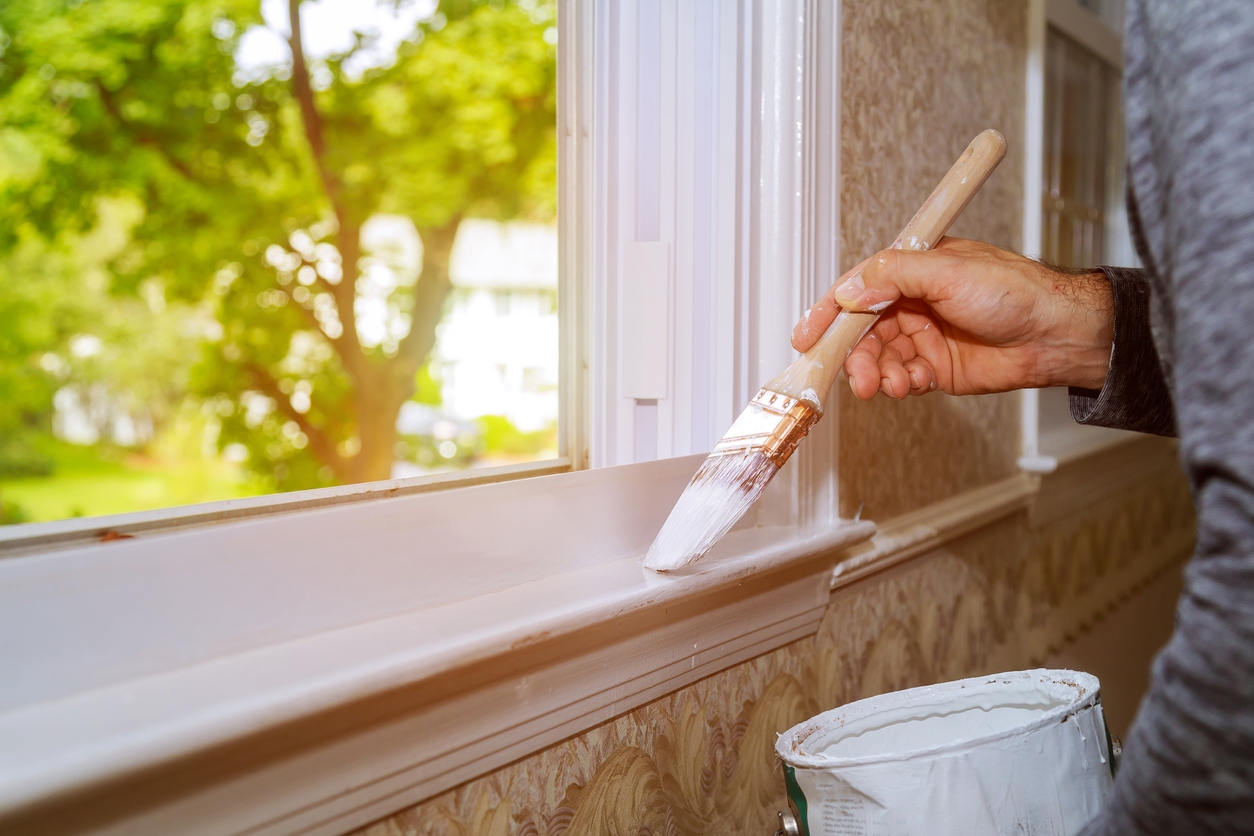Paying attention to details in interior painting means not overlooking the window frames. Painting window frames can enhance the overall look of a room and make it appear more polished and complete. It also helps protect the frames from wear and tear. Read more below as we talk about why painting interior window frames is important and how to do it effectively.
Preparing for the Task
Preparing to paint interior window frames is an important step to achieving a professional finish. Here are some steps to help you prepare for the task.
- Gather Supplies: Collect all necessary supplies, including paint, brushes, painter’s tape, sandpaper, a putty knife, primer, and drop cloths.
- Clean the Frames: Wipe down the window frames with a damp cloth to remove dust, dirt, and grime. This helps the paint adhere better.
- Remove Hardware: Take off any hardware, such as locks or handles, to avoid getting paint on them. Store them safely until the painting is done.
- Protect Surrounding Areas: Use painter’s tape to cover the edges of the glass and surrounding walls. Place drop cloths on the floor to catch any drips or spills.
- Sand the Frames: Lightly sand the window frames to smooth out any rough spots and help the primer and paint stick. Wipe away any sanding dust with a damp cloth.
- Fill Gaps and Holes: Use a putty knife to apply wood filler to any cracks, holes, or gaps in the frames. Allow it to dry, then sand it smooth.
- Apply Primer: Apply a coat of primer to the window frames. This helps the paint adhere better and provides a uniform base color. Let the primer dry completely before painting.
Choosing the Right Paint and Color
Choosing the right paint and color for your interior window frames can greatly enhance the look of your room. Here are some tips to help you make the best choice.
Consider the Room’s Style
Choose a paint color that complements the overall style and color scheme of the room. This ensures the window frames blend in seamlessly and enhance the room’s aesthetic.
Select the Right Finish
A semi-gloss or high-gloss finish is ideal for window frames. These finishes are durable, easy to clean, and resistant to moisture, making them perfect for areas around windows.
Test the Color
Before committing to a color, test it on a small section of the window frame. This helps you see how the color looks in different lighting throughout the day and ensures you are happy with your choice.
Think About Maintenance
Choose a paint that is easy to maintain. High-quality, washable paints are a good option as they can be easily cleaned without losing their color or finish.
Match with Trim
If your room has trim or molding, consider matching the window frame color with these elements. This creates a cohesive look and highlights the room’s architectural details.
Step-by-Step Painting Process
Painting interior window frames can be done efficiently by following a step-by-step process. Follow the steps we provided below to get the best results.
Step 1: Prep the Area
Begin by preparing the area around the window frames. Cover the floor with drop cloths to protect it from paint drips. Use painter’s tape to mask off the glass and any areas you don’t want to paint. Remove any hardware from the window frames, such as handles or locks, and keep them in a safe place.
Clean the window frames thoroughly with a damp cloth to remove dust and dirt. Lightly sand the frames to create a surface that the primer and paint can adhere to. Wipe away any sanding dust with a clean, damp cloth.
Step 2: Apply Primer
Apply a coat of primer to the window frames using a brush. Primer helps the paint stick better and provides a uniform base color. Be sure to cover all surfaces evenly, including the edges and corners of the frames. Let the primer dry completely according to the manufacturer’s instructions.
After the primer has dried, inspect the frames for any imperfections. If necessary, sand the primer lightly to smooth out any rough spots, then wipe away the dust. This will ensure a smooth surface for the paint.
Step 3: Paint the Frames
Start painting the window frames with a high-quality brush. Use long, even strokes to apply the paint, working in sections to avoid visible brush marks. Be sure to paint all the edges and corners carefully to achieve full coverage. Allow the first coat of paint to dry completely.
Once the first coat is dry, apply a second coat of paint for a more durable and even finish. This will help ensure the color is rich and consistent. Let the second coat dry thoroughly before handling the windows or replacing the hardware.
Step 4: Remove Tape and Clean Up
After the paint has dried, carefully remove the painter’s tape from the edges of the glass and surrounding areas. Pull the tape off slowly to avoid peeling any paint from the frames. Clean up any paint drips or splatters immediately with a damp cloth.
Replace any hardware you removed earlier, such as handles or locks. Dispose of the drop cloths and clean your brushes and tools thoroughly. Admire your freshly painted window frames, which should now look crisp and new.
Maintenance and Care
After painting the window frames, it would then be great if you could maintain and care for them, as the longevity of their colors would be extended through proper maintenance. These are a few tips to help you maintain them effectively.
- Regular Cleaning: Wipe down the window frames regularly with a damp cloth to remove dust and dirt. This prevents buildup that can dull the paint.
- Avoid Harsh Chemicals: Use mild soap and water for cleaning. Avoid harsh chemicals that can damage the paint or cause it to peel.
- Touch-Up Scratches: Keep some leftover paint for touch-ups. If you notice any scratches or chips, use a small brush to cover them up and maintain a uniform look.
- Inspect for Damage: Periodically check the window frames for any signs of damage, such as cracks or peeling paint. Address these issues promptly to prevent further deterioration.
- Repaint When Needed: Depending on wear and tear, you may need to repaint the window frames every few years. Follow the same preparation and painting steps to refresh the look.
- Protect from Moisture: Ensure the window frames are properly sealed to prevent moisture from seeping in. This helps avoid wood rot and paint damage.
- Check Caulking: Inspect the caulking around the window frames and replace it if it’s cracked or missing. This helps maintain the seal and prevents drafts.
Conclusion
Painting interior window frames is a key detail that enhances the overall look of a room. It adds a polished finish and helps protect the frames from wear and tear. By preparing properly, choosing the right paint, and following a careful painting process, you can achieve professional results.
However, if you feel like you don’t have the proper skills for painting window frames, you can simply get our services at Custom Painting, Inc. Call us at 925-866-9610 or fill out our Contact Form to know more.



